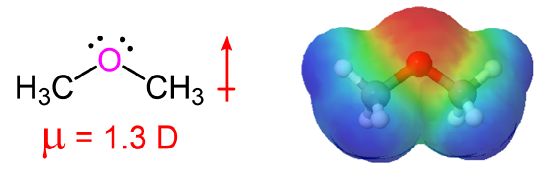Diethyl Ether Polar Or Nonpolar
Concrete Properties of Ether
- Page ID
- 35774
Dimethylether and ethyl methyl ether are gases at ordinary temperature. The other lower homologues are colorless, pleasant smelling, volatile liquids with typical ether smell.
Boiling points
The C - O bonds in ether are polar and thus ethers have a cyberspace dipole moment. The weak polarity of ethers do not appreciably touch their boiling points which are comparable to those of the alkenes of comparable molecular mass. Ethers take much lower boiling points equally compared to isomeric alcohols. This is because alcohols molecules are associated past hydrogen bonds while ether molecules are non.
Solubility
Ethers containing up to 3 carbon atoms are soluble in water, due to their hydrogen bond formation with water molecules.

The solubility decreases with increase in the number of carbon atoms. The relative increase in the hydrocarbon portion of the molecule decreases the trend of H-bail formation. Ethers are appreciably soluble in organic solvents like alcohol, benzene, acetone etc.
Structure of Ethers 
Ethers are a form of organic compounds that contain an sp3 hybridized oxygen betwixt 2 alkyl groups and accept the formula R-O-R'. these compounds are used in dyes, perfumes, oils, waxes and other industrial uses. Aliphatic ethers have no aryl groups directly fastened to the ether oxygen.
Examples of Aliphatic Ethers
Aromatic ethers have at to the lowest degree one aryl ring straight fastened to the ether oxygen. In aryl ethers, the lone pair elections on oxygen are conjugated with the effluvious ring which significantly changes the properties of the ether.
Example of Aromatic Ethers
The sp3 hybridization of oxygen gives ethers roughly the aforementioned geometry every bit alcohols and water. The R-O-R' bond angle is close to what is expected in a tetrahedral geometry. The bond angle of dimethyl ether is 112o which is larger than the H-O-H bond bending in water (104.5o) due to the steric repulsion of the methyl groups.
The presence of an electronegative oxygen atom gives ethers a modest dipole moment.

Comparisons of Physical Properties of Alcohols and Ethers
Ethers, unlike alcohols, have no hydrogen atom on the oxygen atom (that is, no OH group). Therefore, there is no intermolecular hydrogen bonding between ether molecules, which makes their boiling points much lower than an alcohol with similar mass. Despite the presence of a small dipole moment, ethers take boiling points that about the aforementioned alkanes of comparable molar mass. (Table xviii.one.ii).
| Condensed Structural Formula | Name | Molar Mass | Boiling Point (°C) | Intermolecular Hydrogen Bonding in Pure Liquid? |
|---|---|---|---|---|
| CH3CHtwoCH3 | propane | 44 | –42 | no |
| CH3 OCH3 | dime thyl ether | 46 | –25 | no |
| CH3CH2 OH | ethyl alcohol | 46 | 78 | aye |
| CHiiiCHiiCHiiCH2CH3 | pentane | 72 | 36 | no |
| CHiiiCHtwo OCH2CHthree | diethyl ether | 74 | 35 | no |
| CHthreeCH2CH2CHii OH | butyl alcohol | 74 | 117 | yeah |
Ether molecules do have an oxygen atom, even so, and appoint in hydrogen bonding with water molecules. Consequently, an ether has about the same solubility in water as the alcohol that is isomeric with it. For example, dimethyl ether and ethanol (both having the molecular formula C2Hhalf-dozenO) are completely soluble in water, whereas diethyl ether and one-butanol (both CivHxO) are barely soluble in water (viii k/100 mL of water).
Peroxide Formation
Many ethers tin react with oxygen to form explosive peroxide compounds north a complimentary radical process called autoxidation. For this reason ethers should not be stored for long periods of time and should not be stored in glass bottles. The danger is particularly acute when ether solutions are distilled to near dryness. The hydroperoxides can become more concentrated during a distillation considering they tend to accept a slightly higher boiling indicate than the corresponding ether. Before performing an ether distillation peachy care should be taken to test for the presence of peroxides.
Diethyl Ether Polar Or Nonpolar,
Source: https://chem.libretexts.org/Bookshelves/Organic_Chemistry/Supplemental_Modules_(Organic_Chemistry)/Ethers/Properties_of_Ethers/Physical_Properties_of_Ether
Posted by: mcglonelibse1995.blogspot.com


0 Response to "Diethyl Ether Polar Or Nonpolar"
Post a Comment